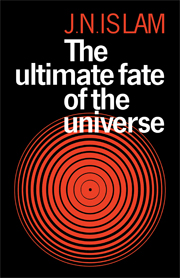Book contents
- Frontmatter
- Contents
- Preface
- Dedication
- Note on some conventions
- 1 Introduction
- 2 Our Galaxy
- 3 The large-scale structure of the universe
- 4 Elementary particles – a preliminary look
- 5 Is the universe open or closed?
- 6 Three ways for a star to die
- 7 Black holes and quasars
- 8 Galactic and supergalactic black holes
- 9 A black hole is not forever
- 10 Slow and subtle changes
- 11 Future of life and civilization
- 12 A collapsing universe
- 13 The steady state theory
- 14 The stability of the proton
- 15 Epilogue
- Glossary
- Selected bibliography
- Index
9 - A black hole is not forever
Published online by Cambridge University Press: 06 July 2010
- Frontmatter
- Contents
- Preface
- Dedication
- Note on some conventions
- 1 Introduction
- 2 Our Galaxy
- 3 The large-scale structure of the universe
- 4 Elementary particles – a preliminary look
- 5 Is the universe open or closed?
- 6 Three ways for a star to die
- 7 Black holes and quasars
- 8 Galactic and supergalactic black holes
- 9 A black hole is not forever
- 10 Slow and subtle changes
- 11 Future of life and civilization
- 12 A collapsing universe
- 13 The steady state theory
- 14 The stability of the proton
- 15 Epilogue
- Glossary
- Selected bibliography
- Index
Summary
In the last chapter we saw that after a billion billion billion (1027) years or so the universe will have two classes of black holes. Firstly there will be the very massive ones, namely galactic and supergalactic black holes. Another class of black holes will be the singly wandering stellar-size black holes (up to a few times the mass of the Sun) which were ejected from galaxies during the stage of dynamical evolution of the galaxy into a single black hole. There will, of course, also be the cold white dwarfs, neutron stars and other smaller pieces of matter (which were thrown out of galaxies) wandering in the intergalactic space. According to the laws of classical physics, all these black holes, white dwarfs, neutron stars etc. will last forever in the same form with very little further change. Perhaps we should explain here what we mean by ‘classical’ physics. ‘Classical’ here does not refer to classical Greece, but to a more modern period. Modern physics in one sense could be said to have started from the work of the Italian mathematician, astronomer and physicist Galileo Galilei (1564–1642) and of Newton. Nearly all the physical phenomena encountered in chemistry, physics and astronomy until about the end of the nineteenth century could be explained in accordance with the mechanistic principles propounded by Galileo and Newton. However, in the twentieth century it was realized that microscopic phenomena and also phenomena involving high velocities and strong gravitational fields could not be explained in terms of the laws of mechanics of Galileo and Newton.
- Type
- Chapter
- Information
- The Ultimate Fate of the Universe , pp. 90 - 95Publisher: Cambridge University PressPrint publication year: 1983



